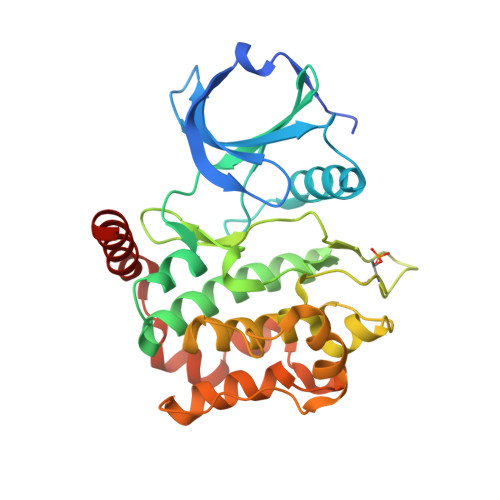Structures of human MST3 kinase in complex with adenine, ADP and Mn2+.
Ko, T.P., Jeng, W.Y., Liu, C.I., Lai, M.D., Wu, C.L., Chang, W.J., Shr, H.L., Lu, T.J., Wang, A.H.J.(2010) Acta Crystallogr D Biol Crystallogr 66: 145-154
- PubMed: 20124694
- DOI: https://doi.org/10.1107/S0907444909047507
- Primary Citation of Related Structures:
3A7F, 3A7G, 3A7H, 3A7I, 3A7J - PubMed Abstract:
The MST family is a subclass of mammalian serine/threonine kinases that are related to the yeast sterile-20 protein and are implicated in regulating cell growth and transformation. The MST3 protein contains a 300-residue catalytic domain and a 130-residue regulatory domain, which can be cleaved by caspase and activated by autophosphorylation, promoting apoptosis. Here, five crystal structures of the catalytic domain of MST3 are presented, including a complex with ADP and manganese, a unique cofactor preferred by the enzyme, and a complex with adenine. Similar to other protein kinases, the catalytic domain of MST3 folds into two lobes: the smaller N lobe forms the nucleotide-binding site and the larger C lobe recognizes the polypeptide substrate. The bound ADP and Mn(2+) ions are covered by a glycine-rich loop and held in place by Asn149 and Asp162. A different orientation was observed for the ligand in the MST3-adenine complex. In the activation loop, the side chain of Thr178 is phosphorylated and is sandwiched by Arg143 and Arg176. Comparison of this structure with other similar kinase structures shows a 180 degrees rotation of the loop, leading to activation of the enzyme. The well defined protein-ligand interactions also provide useful information for the design of potent inhibitors.
Organizational Affiliation:
Institute of Biological Chemistry, Academia Sinica, Taipei 115, Taiwan.

















